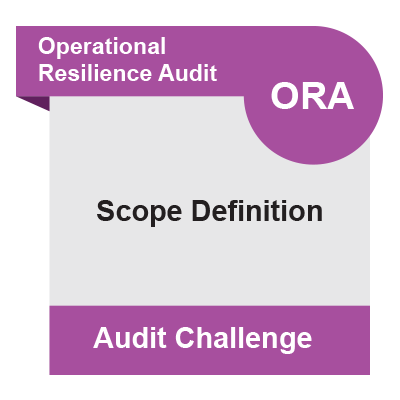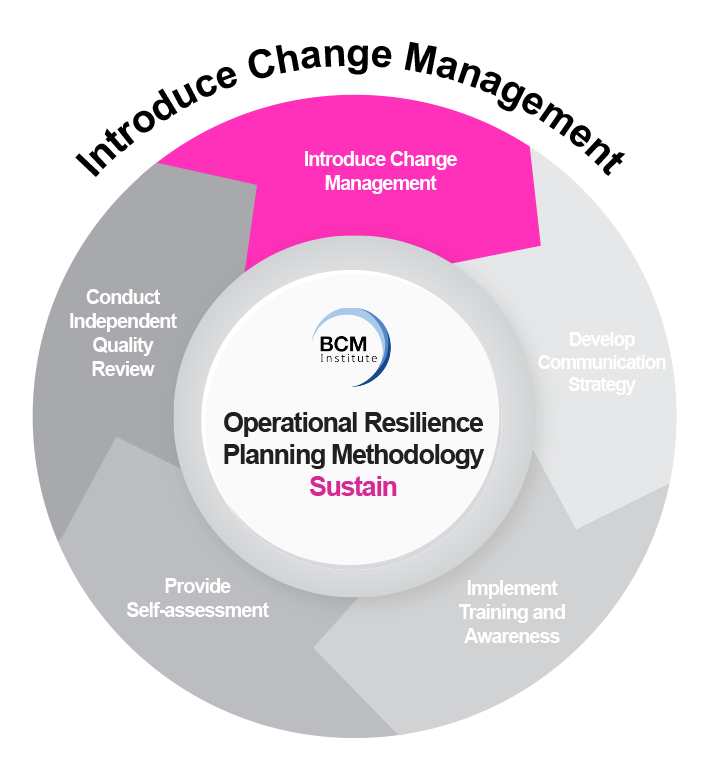ORA Challenges Faced: Scope Definition
Challenges Faced by Auditors when Conducting an Operational Resilience Audit
Scope Definition
Posts by:
Dr Goh Moh Heng is the President of BCM Institute and the Managing Director of GMH Continuity Architects – a specialised BCM Consulting firm. His primary areas of expertise include Business Continuity Management (BCM), Disaster Recovery Planning (DRP), ISO22301 BCM Audit and Crisis Management. Since 2011, Moh Heng has assisted more than 50 organisations, particularly those operating in the Asia-Pacific and Middle-East Region in their successful implementation of their Business Continuity Management System (BCMS) and achieving their BS 25999/ SS 540 / ISO 22301 organisation certification. Prior to establishing BCM Institute and GMH BCM Consulting, Dr. Goh held senior positions with a number of large organizations. During his career with the Government of Singapore Investment Corporation (GIC), he was responsible for all aspects of its business continuity and crisis management. At Standard Chartered Bank Plc, he saw and manage the global implementation of its BC management and planning for 52 countries. He also managed the BCM practice at PricewaterhouseCoopers.

 |
 |
 |
 |
 |
 |
 |
Please feel free to send us a note if you have any of these questions. |
 |
![[BL-HL-ORA-5] What is a OR Audit Expert Blended or Hybrid Learning Course?](https://blog.bcm-institute.org/hubfs/Operational%20Resilience%20Audit/Operational%20Resilience%20Audit%20CTA%20Button/IC_ORA-5000_Course%20Schedule_Square.png)
 The Operational Resilience (OR) Audit blended learning is the most advanced level of OR audit training for certification, financial, IT internal and external auditors.
The Operational Resilience (OR) Audit blended learning is the most advanced level of OR audit training for certification, financial, IT internal and external auditors.
This comprehensive course is equivalent to the international certification of an Operational Resilience (OR) Auditor. Its combination of online interaction allows busy and interested auditors to study with minimal schedule disruption.
This course is NOT a four-day, hour-by-hour direct conversion course from its brick-and-mortar version but revamped with several guiding principles.
Here is a quick overview of the course, divided into modules 1 to 4. Module 1 to 4 and their relationship to the ORA-300-400-5000 level courses are explained.
The conduct of each module is described with the corresponding on-site learning outcome.
Below is a snapshot of what you can expect from the program. Each module's syllabus has been carefully crafted to ensure that the outcome matches each day of the ORA-5000 OR Auditor competency level.
Click the "Course Content" icon to learn more about each module's content (syllabus). Click the "Course Requirement" icon to determine what you can expect as participants for each module.
| Module (Day) | Course Content | Course Requirement |
 |
 |
|
![[BL-ORA] [3] M2 What is ORA-300?](https://no-cache.hubspot.com/cta/default/3893111/73647d96-98df-4207-a85c-b9f80c790cff.png) |
 |
 |
 |
 |
|
 |
 |
 The primary concern with blended learning is that it will be another E-Learning training over a video channel.
The primary concern with blended learning is that it will be another E-Learning training over a video channel.
The entire process is designed such that the content will provide the same outcome with pre-readings provided before the class, preparation of assignments supported by detailed guidance notes, eLearning for learning of fundamentals, and the online "face-to-face" is for sharing and elaboration by experienced facilitators.
Instructors: Note that instructors delivering the modules remain the same as the onsite training. They have at least 5 to 30 years of OR and audit-related experience.
International Participation: Another significant change will be the participation of more international delegates compared to the traditional majority of Asian participants. Be expected to discuss and work as teams from around the world.
Readings: Be expected to have more pre-readings as the objective is to ensure that knowledge that could be acquired via reading should be done outside the training session. More time is allocated to sharing experiences with the participants and facilitators.
Live Audit: Despite being virtual, there is a balance between knowledge-based acquisition activities, presentations, discussions, exercises and case studies. About two-thirds of the time is spent on activity-based learning. A live audit will be conducted.
 This is the course schedule. Click the "ORA-5000 Course Schedule" icon to learn more about the "RUNs" for the year.
This is the course schedule. Click the "ORA-5000 Course Schedule" icon to learn more about the "RUNs" for the year.
Blended Learning is entirely online, Hybrid Learning is Module 1 and 2 online, and Module 3 and 4 onsite.
BCM Institute offers two levels of OR auditing courses: ORA-3 Blended Learning ORA-300 Operational Resilience Audit Specialist and the ORA-5 Blended Learning ORA-5000 Operational Resilience Audit Expert.
 |
 |
 |
 |
 |
 |
 |
![Email to Sales Team [BCM Institute]](https://no-cache.hubspot.com/cta/default/3893111/3c53daeb-2836-4843-b0e0-645baee2ab9e.png) |
 |
 |
Please feel free to send us a note if you have any questions. |  |

|
|
What is Organisational Culture?Organisational Culture is not created by memo or a decision from senior management but developed over time and plays a crucial role in achieving organisational objectives, especially in this new area of operational resilience. |
 This section is the "Implement" phase of the Operational Resilience Planning Methodology. It is the first stage of the Implement phase: Identify Critical Business Services.
This section is the "Implement" phase of the Operational Resilience Planning Methodology. It is the first stage of the Implement phase: Identify Critical Business Services.
Identification of Critical Business Services |
Interdependencies and Interconnections |
Business Impact Analysis |
Risk Assessment |
Business Continuity Planning |
|
Incident Management |
|
Communication and Stakeholder Management |
|
Testing and Exercises |
Training and Awareness |
Continuous Improvement |
Note that some of the steps may overlap with the other stages of the "Implement" phase stages.
 |
 |
 |
 |
![TMM [BL-A-5]](https://no-cache.hubspot.com/cta/default/3893111/e7af9322-15cb-412d-91b6-59cd388ee6e9.png) |
![Register [BL-A-5]](https://no-cache.hubspot.com/cta/default/3893111/bb38417e-6241-4057-b90c-f319f31a494e.png) |
 |
Please feel free to send us a note if you have any of these questions. |
 |


This list of OR Questionnaires is intended to guide Auditors in developing their Standardized Audit Program. Refer to OR Questionnaires.
| Plan | ||||
| Implement | ||||
|
Identify Critical Business Services |
Map Processes and Resources |
Set Impact Tolerance |
Conduct Scenario Testing |
Improve Lesson Learnt |
| Sustain | ||||
|
|
S/No |
BCM Audit Questionnaires |
|
|
|
1 |
BC Roles And Responsibilities |
|
|
|
2 |
Project Management |
|
|
|
3 |
Risk Analysis and Review |
|
|
|
4 |
Business Impact Analysis |
|
|
|
5 |
Business Continuity Strategy |
|
|
|
6 |
Plan Development |
|
|
|
7 |
Testing And Exercising |
|
|
|
8 |
Program Management: Training and Awareness |
|
|
|
9 |
Program Management: Maintenance |
|
|
|
10 |
Crisis Management |
|
Click the icon to access the respective “BCM Audit Questionnaires” questions.

Goh, M. H. (2010). A Manager's Guide to Auditing and Reviewing Your Business Continuity Management Program. Business Continuity Management Specialist Series (1st ed., p. 192). Singapore: GMH Pte Ltd.
Extracted from "Chapters 9 to 13"
Note: This version is the 2nd Edition being updated in 2021. The numeric in the square bracket {C##] is the cross-referencing of the actual chapters in the 2010 Edition.
 |
 |
 |
 |
![TMM [BL-A-5]](https://no-cache.hubspot.com/cta/default/3893111/e7af9322-15cb-412d-91b6-59cd388ee6e9.png) |
![Register [BL-A-5]](https://no-cache.hubspot.com/cta/default/3893111/bb38417e-6241-4057-b90c-f319f31a494e.png) |
 |
Please feel free to send us a note if you have any of these questions to sales.ap@bcm-institute.org |  |
Operational resilience is critical for financial institutions in ensuring uninterrupted services and maintaining the financial system's stability. The Hong Kong Monetary Authority (HKMA) has issued guidelines to provide a comprehensive framework for financial institutions in Hong Kong to enhance their operational resilience.  Referring to the actual "Supervisory Policy" or "SPM OR-2" is important, which sets out HKMA’s approach and supervisory expectations on operational resilience. Refer to the guideline by clicking on the HKMA webpage.
Referring to the actual "Supervisory Policy" or "SPM OR-2" is important, which sets out HKMA’s approach and supervisory expectations on operational resilience. Refer to the guideline by clicking on the HKMA webpage.
This blog aims to provide participants attending the Operational Resilience Implementer and Expert Implementer course with global or regional responsibilities to understand the:
 Operational resilience refers to a financial institution's ability to consistently deliver critical operations and services, even during disruptions or unexpected events.
Operational resilience refers to a financial institution's ability to consistently deliver critical operations and services, even during disruptions or unexpected events.
It encompasses the organisation's ability to prevent, adapt, respond, and recover from operational disruptions to maintain continuity and protect the interests of customers and stakeholders.
Financial institutions are expected to establish an operational resilience framework that integrates people, processes, and technology to enhance their overall resilience.
The framework should include the following components:
The board and senior management should demonstrate clear responsibility and accountability for operational resilience. They should oversee and approve the institution's operational resilience strategy, policies, and risk tolerance levels.
Financial institutions should identify and assess the potential risks and vulnerabilities associated with their critical business services, processes, and systems. This includes conducting regular impact assessments and scenario analyses to understand the potential consequences of operational disruptions.
 Institutions should define their business impact tolerance, reflecting the maximum tolerable disruption to critical services, processes, and systems. This determination should consider the institution's risk appetite, customer expectations, and market conditions.
Institutions should define their business impact tolerance, reflecting the maximum tolerable disruption to critical services, processes, and systems. This determination should consider the institution's risk appetite, customer expectations, and market conditions.
 Institutions should develop robust and comprehensive plans to address operational disruptions effectively. Considering various scenarios and potential impacts, these plans should cover incident response, crisis management, and business continuity.
Institutions should develop robust and comprehensive plans to address operational disruptions effectively. Considering various scenarios and potential impacts, these plans should cover incident response, crisis management, and business continuity.
Regular testing and validation exercises should be conducted to evaluate the effectiveness of the operational resilience framework. Institutions should identify gaps, areas for improvement and implement corrective actions based on the test results.
Institutions should establish clear lines of communication and report for operational disruptions. This includes promptly reporting incidents to the HKMA and maintaining effective communication with customers, stakeholders, and regulatory authorities.
The guidelines emphasise the board's and senior management's crucial role in ensuring operational resilience. They should demonstrate strong leadership, establish a culture of resilience, and promote effective governance practices within the organisation. Key responsibilities include:
The board and senior management should define the institution's strategic objectives regarding operational resilience, aligning them with the overall business strategy.
They should oversee the identification, assessment, and management of operational risks, ensuring appropriate risk controls and mitigation measures are in place.
The board and senior management should allocate sufficient resources, including budget, staff, and technology, to support the implementation and maintenance of the operational resilience framework.
They should establish mechanisms to monitor the effectiveness of the operational resilience framework and receive regular reports on key resilience indicators and performance metrics.
Financial institutions should establish operational resilience parameters to define the levels of resilience required for their critical business services, processes, and systems. These parameters should be determined based on factors such as:
Institutions should consider the criticality and potential impact of a disruption on customers, financial stability, and the broader economy.
 Recovery Time Objectives (RTOs)
Recovery Time Objectives (RTOs)RTOs specify the maximum tolerable downtime for critical services, processes, and systems, guiding the planning and recovery strategies.
 RPOs define the maximum acceptable data loss in case of disruptions, guiding data backup and recovery measures.
RPOs define the maximum acceptable data loss in case of disruptions, guiding data backup and recovery measures.
Institutions should consider the dependencies and interconnections between their internal and external systems and third-party service providers to ensure comprehensive resilience.
 Financial institutions must map the interconnections and interdependencies that underlie their critical operations. This includes identifying the key business services, processes, systems, and resources, both internal and external, on which their operations rely.
Financial institutions must map the interconnections and interdependencies that underlie their critical operations. This includes identifying the key business services, processes, systems, and resources, both internal and external, on which their operations rely.
By mapping these interconnections, institutions can understand the potential impact and dependencies in the event of disruptions. This knowledge enables them to identify vulnerabilities and implement appropriate measures to enhance resilience.
Financial institutions should proactively prepare for and manage risks that could affect the delivery of critical operations.
This involves robust risk assessments to identify potential threats, vulnerabilities, and impacts. Institutions must establish risk management frameworks that identify, measure, monitor, and mitigate risks. These frameworks should align with the institution's risk appetite and regulatory requirements. By effectively managing risks, institutions can enhance their ability to withstand disruptions and ensure the continuity of critical operations.
Financial institutions must test their ability to deliver critical operations under severe yet plausible scenarios.
This includes scenario-based exercises to simulate disruptions and assess the institution's response and recovery capabilities. Testing should cover various aspects, such as incident response, crisis management, communication, and business continuity. Regular testing helps identify weaknesses, refine response plans, and enhance the institution's overall operational resilience.
Financial institutions should establish robust response and recovery plans to address operational incidents effectively.
This involves defining clear roles, responsibilities, and escalation procedures to ensure a coordinated response. Institutions should also establish mechanisms for timely communication with stakeholders, including customers, regulators, and relevant authorities.
By promptly responding to incidents and implementing effective recovery measures, institutions can minimise the impact on critical operations and expedite the restoration of services.
 Financial institutions are expected to implement operational resilience requirements throughout their organisation.
Financial institutions are expected to implement operational resilience requirements throughout their organisation.
This includes embedding a culture of resilience, providing appropriate training and awareness programs for employees, and integrating operational resilience considerations into decision-making processes.
Institutions should allocate sufficient resources to support the implementation of operational resilience requirements and establish mechanisms for monitoring, reporting, and ongoing improvement.
The HKMA's guidelines on operational resilience provide financial institutions in Hong Kong with a comprehensive framework to strengthen their operational resilience.
By considering the general principles outlined in these guidelines, institutions can develop robust operational resilience frameworks that ensure the continuity of critical operations and protect the interests of customers and stakeholders.
Implementing these guidelines is essential for maintaining the financial system's stability and safeguarding the reputation of financial institutions in Hong Kong.
To learn more about the course and schedule, click the buttons below for the OR-3 Blended Learning OR-300 Operational Resilience Implementer course and the OR-5 Blended Learning OR-5000 Operational Resilience Expert Implementer course.
 |
 |
 |
 |
 |
![[BL-OR] [3-4-5] View Schedule](https://no-cache.hubspot.com/cta/default/3893111/d0d733a1-16c0-4b68-a26d-adbfd4fc6069.png) |
![[BL-OR] [3] FAQ OR-300](https://no-cache.hubspot.com/cta/default/3893111/f20c71b4-f5e8-4aa5-8056-c374ca33a091.png) |
If you have any questions, click to contact us.![Email to Sales Team [BCM Institute]](https://no-cache.hubspot.com/cta/default/3893111/3c53daeb-2836-4843-b0e0-645baee2ab9e.png) |
 |